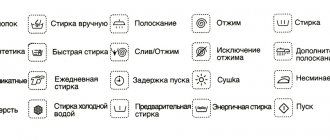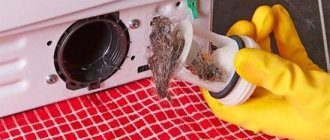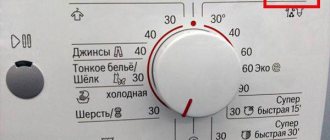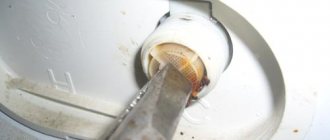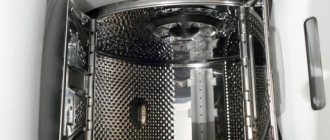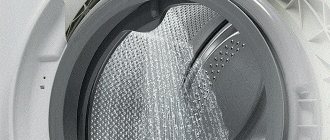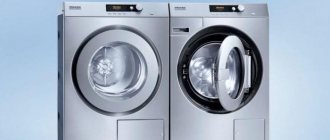An automatic washing machine is good because it does not require the participation of the owner - just select a program, and after a certain time, take out clean laundry and hang it up. But there are situations when the washing cycle cannot be completed, the washing machine freezes, does not spin things out, or, on the contrary, washes for several hours without stopping. The washing machine does not finish washing for various reasons, and not all of them require repair or replacement of equipment.
What to do if the washing machine does not stop?
Many reasons why a car freezes are not related to component failures. Often the problem arises due to the inattention or carelessness of the equipment owner. First of all, pay attention to possible everyday causes of freezing:
Non-spin program type selected
The machine stops with a full tank of water and waits for the user to turn on the drain function. To end the cycle, spin or drain the water.
Too much laundry loaded
If the machine is overloaded, the protection will work and the spin will not start to protect the equipment from excessive loads. Do not exceed the permissible weight of items and remember that wet laundry weighs more than dry laundry.
The weight in the drum is unevenly distributed
If the laundry collects in one lump, an imbalance occurs and the spin cycle freezes. It is necessary to select items for washing so that they are evenly distributed throughout the machine drum.
Important! If you follow the operating rules and carefully handle the equipment, such problems will not occur. Moreover, the service life of the washing machine will increase significantly.
Control module is faulty
If the main “brain” of the washing machine, the control module, fails, then the washing process can also drag on for an indefinite period of time. There is a failure in the control program and the machine cannot understand when to finish washing.
The laundry can be put into washing for the second, third cycle and so on until you turn off the power. There is only one recipe here - call a technician, since it will require disassembling the equipment, diagnosing the module and other actions that are incomprehensible to the average user.
Why does the washing machine wash without stopping?
In addition to the carelessness of the owners, there are other reasons why the washing machine does not stop, not related to faulty parts. These include:
- incorrect connection of the drain hose - water will constantly circulate in the machine, if the drain hose is connected incorrectly, you must follow the rules for installing the washing machine specified in the instructions;
- problems with the water supply system - if water does not enter the tank, the washing time increases, make sure that there is a water supply, the tap is not closed, the supply valve is working, and also check the condition of the filter mesh to see if there is a blockage;
- clogged drain system - if the machine freezes during rinsing or spinning, the pipes, filter or hoses may be clogged and will need to be thoroughly cleaned.
In such cases, the owner of the unit can find and eliminate the reason that the washing machine does not stop. If you carefully read the instructions after purchasing a new device, you will be able to avoid many problems.
The washing process is endless or takes too long
There may be several options here.
- Option one - the heating element (heating element) has partially or completely burned out. The water does not heat up at all or very slowly, so the automation does not give a signal to spin and continue the cycle - the clothes were not washed in cold water! It is necessary to replace the heating element with a new one.
- Option two: the water drain hose is lying on the floor. The heated water is gradually drained into the sewer system, and sensors send a signal to add more water. Thus, the heating element does not have time to heat the water to the required temperature, so the process is delayed or becomes non-stop. You need to secure the drain hose higher or do the correct installation of connecting the washing machine to the water with the help of an experienced technician.
- Option three: the electronic control module is frozen or broken. A non-specialist cannot solve such a problem on his own. The module needs to be rebooted or repaired, and its complete replacement is not excluded.
The main breakdowns due to which the washing machine does not finish washing:
- Failure of the water level sensor - the pressure switch detects the water level in the tank and transmits a signal to the control element when it is necessary to start rinsing, spinning, draining. If the pressure switch breaks down, this signal is not transmitted, the washing stops or continues continuously.
- The heating element is faulty - if 15 minutes after starting the washing machine freezes and the hatch glass is cold, there is a problem with the heater. The machine will not wash when one of the programmed events does not occur (the desired temperature is not reached). The heating element needs to be cleaned, and special descaling agents must be used to prevent damage.
- Problems in the control unit - if the washing does not stop in the washing machine, but the cycle repeats again, this is due to a problem with the control board. The washing machine will wash and spin again and again, which is dangerous for both equipment and laundry.
- The hall sensor is damaged - the tachometer controls the rotation speed of the drum during washing and connects the control unit with the motor. If the sensor does not transmit the required signal, the drum stops spinning and an error message appears on the display.
- Bearing failure - the problem manifests itself when the washing machine spins, when the drum spins quickly, picks up speed, and the machine shakes and hums. Parts are replaced when the first malfunctions appear, so as not to aggravate the situation.
- Faulty shock absorbers - parts smooth out vibrations of the drum at high speeds, so when loud knocks are heard during the spin cycle during the rinse cycle, the machine shakes and jumps, this indicates a breakdown of the shock absorbers. They are replaced in pairs at once.
- Wear of motor brushes - due to constant friction, the brushes wear out, the contact weakens and the washing machine freezes. When the drum picks up speed, the engine may crackle and spark.
The program does not turn off, the wash starts again
Here the problem can only be in the programmer or control board. The command to end the wash does not go through, so the washing machine starts all over again. We need diagnostics of the entire electronic control module and its subsequent repair or replacement.
As you can see from this review article, there may be several reasons for the washing machine not turning off. Some of these reasons can be eliminated with your own hands, but in most cases you will need help. It is possible and necessary to extend the life of your washing machine, but to do this you should contact good craftsmen for whom repairing washing machines is their narrow specialization. Our service repairs the most popular brands of automatic washing machines from such manufacturers as LG, Samsung, Indesit, Electrolux, Bosch, Ardo, Whirlpool, Siemens, Zanussi, Beko and some others. To make washing your clothes a joy, inexpensive and high-quality repairs with a guarantee at home are just what you need. Contact us and we will help you!
Error codes
To find out what exactly caused the malfunction, the machine is often helped by error codes that light up on the display.
| Error code | Meaning |
| F-05 | Drain system is faulty |
| F-04, F-10 | Breakdown of the pressure switch |
| F20 | Problems with the control board, no water supply or self-draining |
| P.E. | Malfunction of the water level sensor or low pressure in the water supply |
You can find a complete list of combinations in the device instructions.
Important! If the electronics fail, the display will not display an error code.
The wash took longer than usual
According to statistics, 95% of users have no idea how long a machine washes in normal mode. Automatic machines relieve owners from participating in the process, so a prolonged washing cycle is always discovered by chance. To identify the reasons for the long washing of the machine after many years of use of the household appliance, it is necessary to take into account the following factors:
- signals for switching washing program operations are provided by sensors that respond to different washing conditions
- scale crust on the walls of the heating element will reduce the heating temperature, after which the automation will get stuck in the heating mode and will not be able to turn on the washing command
Checking the connection of a household appliance to the sewage system will help you understand why the water is constantly heating up and the main wash mode cannot turn on. The portion of water entering the drum heats up and goes down the drain if connected incorrectly.
The most likely reasons for the washing machine to work without stopping are:
- clogged filter - the mesh at the CHC inlet is clogged, water does not flow into the tank
- the hose is bent - the liquid cannot straighten it under its own pressure
- electronics failure - consequences can be unpredictable
In the first two cases, water will flow into the machine very slowly, stable operation of the specified program will remain, but the washing time will increase significantly.
conclusions
If the washing machine does not stop or freezes due to a blockage or problems with the water supply, you can solve the problem on your own. If the main reason is internal failures, it is better to entrust the repair to a specialist. The price of a professional’s work will be lower than purchasing parts, which you will have to pay for separately if you try to eliminate the cause of the freeze yourself.
To get advice by phone or call a specialist to your home, leave a request on the Tandem service website or call.
How to stop an “enraged” device?
What to do if the automatic machine is stuck on the spin cycle and does not want to stop the drum? Such “mad” rotation at high speed can lead to overheating of the unit and damage to the bearings. Therefore, first of all, you should turn off the washing machine, but how to do this as safely as possible? This is how you need to do it. To begin, press the Start/Pause button. After this, the rotation of the drum should begin to slow down. So, after a few seconds, the “centrifuge” will stop completely.
If turning off the button does not help, you will simply have to turn off the power to the machine by unplugging the power cord from the outlet.
Of course, such an action is dangerous for the machine, but leaving it for a long time with a rotating drum is no less dangerous. Therefore, without hesitation, disconnect the device from the power supply.
Machine operating mode
If the washing assistant does not remove stains well, then make sure that the program used for washing corresponds to the type of fabric and the recommendations left by the clothing manufacturer on the label. Often the washing machine does not cope with the function assigned to it, because the selected mode is not intended for the clothes that were immersed in the drum.
As you know, synthetic and delicate fabrics such as silk and wool cannot withstand high temperatures, and it is almost impossible to remove stains from cotton without boiling. Thus, if you do not wash in a special mode, then it is pointless to wonder why the washing machine does not wash away stains on clothes well.
If you load a cotton T-shirt with a stubborn, old stain into the drum, but set the washing program to a temperature no higher than 30-40 degrees, then the stain will remain on your item.
Therefore, in order not to overwash your clothes and not damage the machine itself, choose a program that corresponds to the information on the tag, sort the laundry correctly and do not overload the machine.
Bearing unit and drive
Most often, problems with drum rotation are observed due to broken bearings. In such a situation, an automatic machine makes a lot of noise and hums during operation, a grinding sound is heard, and significant play in the “centrifuge” may be observed.
Broken bearings make it difficult for the drum to rotate, so the machine cannot reach the speed necessary for spinning and freezes.
If you have no desire to repair your old machine, it is better to take it to a workshop, or buy a new machine. When extra expenses are not included in your plans, you can do the repairs yourself. Replacing bearings is not an easy process and will require a lot of effort and time. First, you need to purchase replacement components. They must fit the specific model of washing machine. Next, you need to almost completely disassemble the washing machine and remove the tank from it.
It’s good if your “home assistant” is equipped with a collapsible tank. Then you just need to halve it, gain access to the drum, knock out the old ones and press in new bearings, not forgetting to replace the oil seal. The machine is assembled in the reverse order.
If the assembly is cast, more time will have to be spent on repairs. First, the plastic is sawed with a hacksaw along the weld seam, then the bearings and seal are changed. When connecting the halves, you need to use silicone moisture-resistant sealant - this will restore the tightness of the tank.
When the bearings are good but the spin cycle is not working, observe how the machine operates just before it freezes. If you hear a subtle whistle and the speed of rotation of the drum slows down, be sure to inspect the drive belt. When the rubber band is stretched, it “slips” along the pulley, causing the speed to drop. To check the belt you need to:
- turn off the power to the machine;
- turn off the water supply tap;
- remove the top panel of the machine;
- Remove the back wall of the case by unscrewing the screws securing it.
Inspect the drive belt. If it is damaged, replace the rubber band. For this:
- remove the old belt from the pulley;
- Pull the new rubber band first onto the engine pulley, then onto the drum “wheel”;
- Reassemble the washer body in reverse order.
Of course, it would be useful to immediately check the pulleys directly to see if they are deformed. Particular attention should be paid to the drum “wheel”. Even a slightly noticeable bend or a small burr will have a negative impact on the drive belt, causing it to wear.





